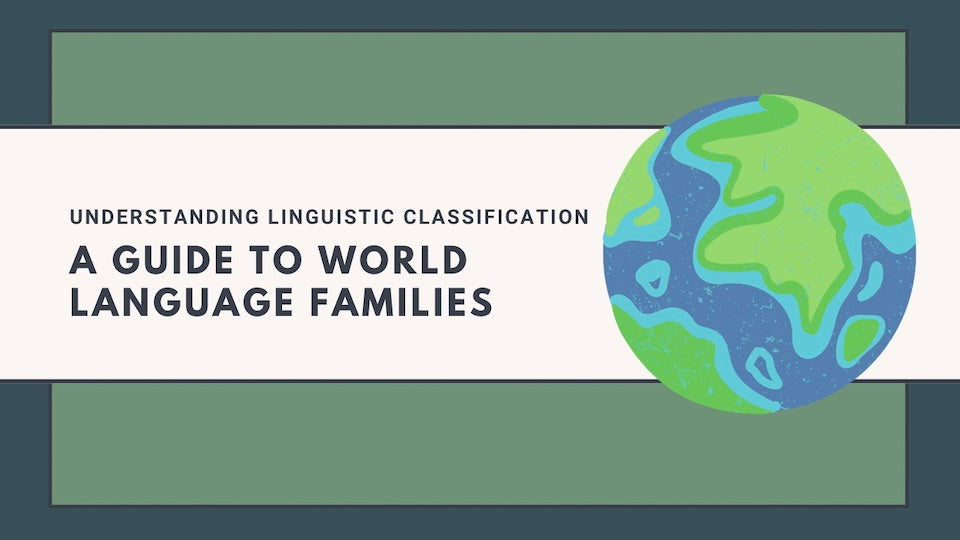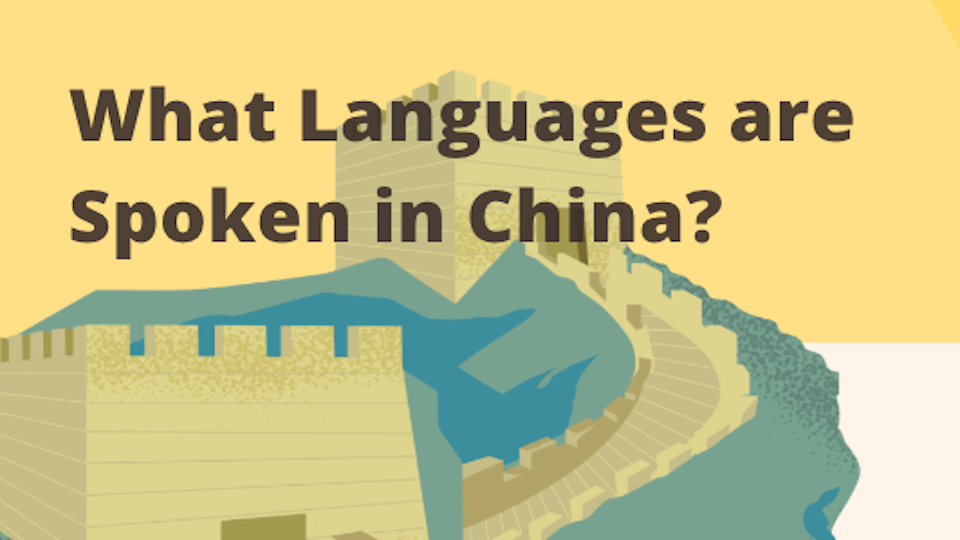
Understanding Linguistic Classification: A Guide to World Language Families
Do you ever wonder how linguists make sense of all the languages spoken on our planet? Language classification helps us understand where they come from, how they’re related and what they look like. This guide covers how languages are grouped, the big language families around the world and why it matters for communication and translation.
How Languages Are Classified: The Three Main Approaches
Languages aren't randomly categorized. Linguists use three primary classification methods to organize and understand the world's diverse tongues.
| Classification Method | Definition | Basis of Grouping | Key Example | Strengths | Limitations |
|---|---|---|---|---|---|
| Genealogical (Historical/Genetic) | Classifies languages based on shared ancestry | Common origin (proto-languages) | Indo-European → English, Hindi, Spanish | Shows historical connections; helps trace language evolution | Hard to classify isolated or undocumented languages |
| Areal | Groups languages based on geographic proximity and mutual influence | Shared features due to contact | Balkan Sprachbund: Greek, Albanian, Romanian | Captures language convergence in multilingual regions | May group unrelated languages; not based on ancestry |
| Typological | Classifies based on structural or grammatical features | Word order, morphology, phonology, etc. | SVO vs SOV languages; isolating vs agglutinative | Cross-family comparisons; reveals universal patterns | Not based on history or geography; overlaps possible |
Genealogical Classification: Tracing Language Families
Genealogical classification groups languages by their common ancestor. Just like family trees show relationships between relatives, language families show how languages branch off from a common ancestor. For example, English, German and Swedish are in the Germanic branch of the Indo-European family because they came from the same ancestor.
This method compares vocabulary, grammar and sound systems to find similarities that show common origin. When languages have systematic sound correspondences and core vocabulary (like numbers, body parts or natural elements) linguists can establish their historical relationship. This is key to understanding how languages have diverged over time and how they have borrowed from each other through historical contact and migration.
Areal Classification: Geographic Influence on Language
Languages that are close to each other will influence each other regardless of their genetic relationship. Areal classification looks at these geographic influences, at the features languages acquire through contact.
For example, languages in the Balkans (Albanian, Bulgarian, Greek and Romanian) are from different branches of the Indo-European family but have grammatical features in common because of centuries of contact. These common features are called "Balkanisms" and include postposed articles and similar case systems that developed through areal interaction not common ancestry. This shows how languages are dynamic and change through contact with other languages.
Typological Classification: Structural Similarities
Typological classification groups languages by their structure not their history. This looks at things like word order, sound systems and grammar.
For example languages can be synthetic (like Russian, with complex word forms that carry multiple meanings) or analytic (like Chinese, with simple word forms and grammar expressed through word order). Other typological features include whether a language puts verbs at the beginning, middle or end of a sentence, or how it forms questions and negations. This way linguists can compare languages that aren’t related but have similar structures and get a sense of the range of human language.
Major Language Families Across Global Regions
Now let's explore the primary language families across different regions of the world.
| Language Family | Major Languages | Primary Regions / Continents | Notable Countries |
|---|---|---|---|
| Indo-European | English, Spanish, Hindi, Russian, French | Europe, South Asia, Americas | USA, UK, India, Russia, France, Spain |
| Sino-Tibetan | Mandarin, Cantonese, Burmese, Tibetan | East Asia, Southeast Asia | China, Myanmar, Tibet |
| Afro-Asiatic | Arabic, Hebrew, Amharic, Somali | North Africa, Middle East, Horn of Africa | Egypt, Saudi Arabia, Ethiopia, Israel |
| Niger-Congo | Swahili, Yoruba, Zulu, Igbo | Sub-Saharan Africa | Nigeria, Kenya, South Africa |
| Austroasiatic | Vietnamese, Khmer (Cambodian), Mon | Southeast Asia | Vietnam, Cambodia |
| Austronesian | Tagalog, Javanese, Malay, Hawaiian | Pacific Islands, Southeast Asia | Philippines, Indonesia, Madagascar |
| Dravidian | Tamil, Telugu, Kannada, Malayalam | South India, Sri Lanka | India, Sri Lanka |
| Turkic | Turkish, Uzbek, Kazakh, Uyghur | Central Asia, parts of Eastern Europe | Turkey, Uzbekistan, Kazakhstan, China |
| Uralic | Finnish, Hungarian, Estonian | Northern & Eastern Europe | Finland, Hungary, Estonia |
| Altaic (disputed) | Turkish, Mongolian, Korean, Japanese | Central & East Asia | Turkey, Mongolia, Korea, Japan |
| Amerind (proposed) | Quechua, Nahuatl, Guarani | Central and South America | Peru, Mexico, Paraguay |
| Isolate Languages | Basque, Ainu, Korean (if isolate) | Various | Spain (Basque), Japan (Ainu), Korea |
European Languages: Ancient Roots and Modern Diversity
Europe's linguistic landscape is dominated by two major families:
The Indo-European family covers most of Europe and includes several branches:
- Romance languages (French, Spanish, Italian, Portuguese, Romanian)
- Germanic languages (English, German, Dutch, Swedish, Norwegian)
- Slavic languages (Russian, Polish, Czech, Bulgarian, Serbian)
- Celtic languages (Irish, Welsh, Scottish Gaelic)
- Baltic languages (Lithuanian, Latvian)
- Greek and Albanian, each forming their own branches
The Uralic family occupies northern and eastern Europe, including:
- Finnic languages (Finnish, Estonian)
- Sami languages (northern Scandinavia)
- Hungarian, which stands somewhat isolated geographically from other Uralic languages
Europe also hosts several language isolates like Basque, which shows no proven relationship to any other living language. This diversity reflects the continent's complex history of migration, conquest, and cultural exchange.
Asian Languages: Incredible Diversity
Asia features remarkable linguistic diversity with several major families:
The Indo-European family extends into Asia through:
- Indo-Iranian languages (Hindi, Urdu, Persian, Bengali, Nepali)
The Sino-Tibetan family includes:
- Chinese languages (Mandarin, Cantonese, Wu, Min)
- Tibeto-Burman languages (Tibetan, Burmese, Nepalese languages)
The Dravidian family dominates southern India:
- Tamil, Telugu, Malayalam, Kannada
The Austro-Asiatic family spans Southeast Asia:
- Vietnamese, Khmer, and various tribal languages
Other significant Asian language families include Japonic (Japanese), Koreanic (Korean), Tai-Kadai (Thai, Lao), and Turkic languages in Central Asia. This diversity is a testament to Asia's vast geographical expanse and its role as a cradle of ancient civilizations.
African Languages: Rich Linguistic Heritage
Africa hosts over 2,000 languages grouped into several major families:
The Niger-Congo family is Africa's largest:
- Bantu languages (Swahili, Zulu, Shona)
- West African languages (Yoruba, Igbo, Akan)
The Afro-Asiatic family spans North Africa and the Horn:
- Semitic languages (Arabic, Amharic, Tigrinya)
- Berber languages (Tamazight, Kabyle)
- Cushitic languages (Somali, Oromo)
The Nilo-Saharan family stretches across central Africa:
- Nilotic languages (Dinka, Maasai, Luo)
- Saharan languages (Kanuri, Teda)
The Khoisan languages of southern Africa are notable for their click consonants. Africa's linguistic landscape is a reflection of its rich cultural history and the diverse peoples who have inhabited the continent for millennia.
Middle Eastern Languages: Crossroads of Civilizations
The Middle East represents a linguistic crossroads with three dominant families:
The Afro-Asiatic family includes:
- Semitic languages (Arabic, Hebrew, Aramaic)
The Indo-European family is represented by:
- Iranian languages (Persian, Kurdish)
The Turkic family includes:
- Turkish, Azerbaijani, Turkmen
This region's languages have deeply influenced world history, religious texts, and early writing systems. The Middle East's strategic location has made it a melting pot of cultures and languages, contributing to its rich linguistic tapestry.
North American Languages: Pre-Columbian Diversity
Before European colonization, North America featured remarkable linguistic diversity with dozens of language families:
The Algic family spans much of northeastern North America:
- Algonquian languages (Cree, Ojibwe, Blackfoot)
The Na-Dene/Eyak-Athabaskan family extends from Alaska to the American Southwest:
- Navajo, Apache, Dene languages
The Iroquoian family includes:
- Cherokee, Mohawk, Seneca
The Uto-Aztecan family stretches from the Great Basin to Central Mexico:
- Hopi, Comanche, Nahuatl (Aztec)
North America also features numerous Creole languages that emerged from European colonization, including Louisiana Creole and Gullah. This diversity reflects the continent's complex history of indigenous cultures and the impact of European settlement.
South American Languages: Amazonian Treasures
South America hosts hundreds of languages across numerous families:
The Quechuan family includes:
- Quechua dialects (the language of the Inca Empire)
The Aymaran family:
- Aymara and related languages
The Tupian family:
- Tupi, Guarani (an official language of Paraguay)
Many South American languages remain poorly documented, with the Amazon Basin representing one of the world's most linguistically diverse regions. This diversity is a testament to the continent's rich indigenous heritage and the resilience of its native peoples.
Oceanic Languages: Island Diversity
The Pacific region features two primary language families:
The Austronesian family spans from Madagascar to Easter Island:
- Polynesian languages (Hawaiian, Māori, Samoan)
- Melanesian languages
- Micronesian languages
- Malayo-Polynesian languages (Indonesian, Tagalog, Malay)
The Pama-Nyungan family covers most of Australia:
- Aboriginal Australian languages (Warlpiri, Pitjantjatjara)
Papua New Guinea alone hosts over 800 languages, making it the world's most linguistically diverse country per capita. This diversity reflects the region's complex history of migration and settlement across vast oceanic distances.
Special Language Categories: Beyond Family Classification
Beyond traditional language families, several special categories help us understand linguistic diversity.
Language Isolates: Standing Alone
Language isolates have no demonstrable relationship with any other language. Examples are Basque in Spain/France, Burushaski in Pakistan, Ainu in Japan. These languages are unique linguistic lineages that have survived while their relatives if any existed have disappeared. Studying these isolates gives us valuable insights into the history of human language and the factors that contribute to language survival and extinction.
Pidgins and Creoles: Languages Born from Contact
Pidgins develop when people speak different languages. These simplified communication systems have less vocabulary and grammar. When kids grow up speaking a pidgin as their first language, it can evolve into a creole—a full language with more vocabulary and complex grammar.
Examples are Haitian Creole (French-based), Tok Pisin in Papua New Guinea (English-based), and Papiamento in the Caribbean (Spanish/Portuguese-based). These languages show how language evolves and how humans adapt language to meet their needs.
Lingua Francas: Bridging Communication Gaps
A lingua franca is any language systematically used for communication between people who don't share a native language. Throughout history, different languages have served this role in various regions:
- Latin in medieval Europe
- Arabic in parts of Africa and the Middle East
- Swahili in East Africa
- English globally today
Lingua francas facilitate trade, diplomacy, and cultural exchange, playing a crucial role in global communication. Understanding the role of lingua francas helps us appreciate the ways in which languages can transcend cultural and linguistic boundaries to foster understanding and cooperation.
Leveraging Linguistic Knowledge for Better Communication
Language classification is key to communication across languages. For global businesses it’s key to developing better translation and localisation strategies.
Companies like Smartling use linguistic insights to get translation right so content resonates with target audiences and respects language nuances. By understanding language families and their relationships translators can navigate tricky concepts and cultural references. This is key to creating content that’s culturally relevant and linguistically accurate and to building global connections.
Conclusion: The Living Map of Human Language
Language classification is a window into human history, migration and cultural exchange. As we become more connected as a world understanding the relationships between languages helps us bridge the communication gap and appreciate language diversity.
While thousands of languages will disappear in the next few decades language classification helps preserve knowledge of these unique systems of human communication. By documenting and studying language relationships we keep the connections to our shared human heritage. This is vital to preserving the language diversity that makes our world richer and to ensure future generations can learn from and appreciate the many human languages.
FAQs About Language Classification
How many languages are currently spoken in the world?
Linguists estimate that there are around 7,000 languages spoken worldwide, though the number is always changing as there are languages that are fading out and new ones emerging or being discovered or being grouped. This flux of language is a reflection of the ongoing processes of adaptation and cultural change.
What is the largest language family in the world?
The Niger-Congo family contains the most in number of separate languages, over 1,500 languages. There are fewer languages but the largest number of speakers in the Indo-European family. Identification of these families provides an appreciation of the size and diversity of human language usage.
Can languages belong to multiple families?
Languages tend to be members of just one genetic family but can exhibit characteristics from multiple families through borrowing and areal influence. Others posit "mixed languages" in which characteristics of multiple source languages are combined in systematic manner. This is evidence of the suppleness of language and how languages can evolve and change through contact and exchange.
What's the difference between a dialect and a language?
The distinction is often political rather than linguistic. The familiar saying "a language is a dialect with an army and navy" shows the manner in which social and political factors influence categorization. Linguistically, mutual intelligibility (i.e., whether the speakers are able to understand one another) is a key consideration. This split acknowledges the very complex interrelation between language, identity, and power.
Are sign languages related to spoken languages?
Sign languages diverge from spoken languages and have their own kinship. American Sign Language, for example, is closer to French Sign Language than to British Sign Language, although not necessarily reflecting the relation between English and French. This autonomy is used to highlight the uniqueness of sign languages and their status as full linguistic systems.






















